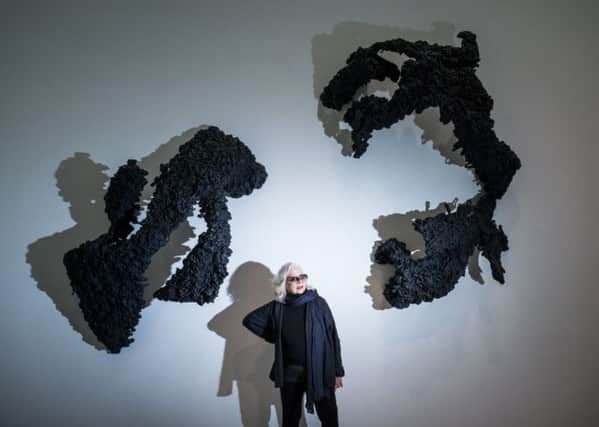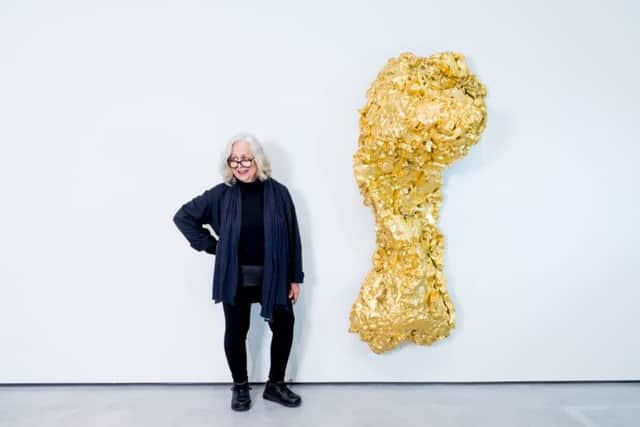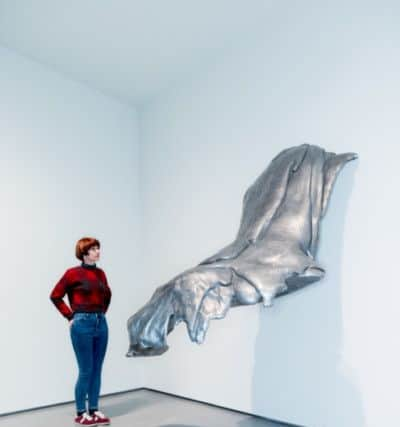Lynda Benglis: Off the wall by nature


Gutsy, confrontational, mildly shocking but with an unmistakable sense of playfulness and irony sums up the image for which Greek-American artist Lynda Benglis is best known. It’s now more than 40 years since Centrefold first appeared in Artforum magazine but it is testament to its lasting power that the image still provokes discussion. A self-portrait of the young Benglis, in the photograph she is naked (save for a pair of white-framed sunglasses), looking defiantly straight at the camera. Oh and she also happened to be holding a sex toy.
An artist of great range and versatility, over her 50-year career Benglis has worked in a variety of forms – sculpture, painting, photography, film – and in diverse materials including pigmented beeswax, polyurethane foam, fabric, glass, metal and more recently paper and ceramics.
Advertisement
Hide AdAdvertisement
Hide AdAs I wait to meet the renowned artist and creative champion of feminist politics at the Hepworth Wakefield, where the first major UK retrospective of her work opened earlier this month, I reflect upon how appropriate it is for the show to be taking place in this particular gallery. After all, like Benglis, who first made her mark in the robustly masculine New York art world of the late 1960s, Hepworth was similarly a woman forging her way in what was at the time a very male-dominated arena.


When she arrives, fresh from an enjoyable trip to the Yorkshire Sculpture Park (“I loved it,” she declares), Benglis is warm, expansive and good company. At 73, she is one of America’s most significant living artists and remains prolific, continuing to challenge the traditions of sculpture and painting and still experimenting with form and material. She is keen to talk about her latest works in ceramics (small-scale, beautifully textured and brightly coloured work) and polyurethane (tall, fluid “fountains”, full of movement) along with several delicate moulded paper works that are being exhibited publicly for the first time.
“As a student I majored in ceramics and painting,” she says. “And I started back with ceramics in the early 1990s and have been working on that pretty constantly off and on, creating experimental pieces and combining paper and ceramics. Now I am making my own paper in my studio in Santa Fe.”
Benglis has studios in four locations. As well as the aforementioned New Mexico base, she divides her time between New York, Ahmedabad in India and Kastelorizo in Greece with each place – its colours, motifs, landscapes and methods of fabrication (she often collaborates with local craftspeople) – providing inspiration for her work and exerting a subtle influence on it.
Advertisement
Hide AdAdvertisement
Hide Ad“There is a visual connection, especially with nature,” she adds. Benglis has said in the past that all her work is in some sense inspired by the natural world. “Absolutely, and nature does have to do with location and also with how you have a connection in terms of people – the socialisation of location.”


Her first experience of the importance of this link with place came when she was 11 and travelled to Greece with her paternal grandmother. “We visited her home island and I loved the landscape there,” she says. “Coming from a very flat, muddy, bayoux area in Louisiana, I was very touched by the rocks. It felt very safe there and my grandmother let me run around – I took photographs of the landscape with my little Brownie camera. There were some caves where you could swim and see the phosphorescence and there is a natural buoyancy because there is an amazing amount of salt in the water, the water feels like silk – and visually you are surrounded by this glow. There is all this sensory material around you. I began to think about what phosphorescence is and does, what the light does, how we perceive things and how we connect with them.”
Early works in the exhibition that reflect this fascination with light, colour and texture include Night Sherbert (1968) created from Day-Glo pigment, phosphorescence and poured polyurethane foam, and Rumpled Painting/Caterpillar (1968), made of poured pigmented latex. Later work features a series of glitter-encrusted “knots” such as Sparkle Knot IV (1970), one of the colourful wall-mounted “peacock series”. Zanzidae (1979), constructed from wire mesh, enamel, glass and plastic, and the brash molten glitz of the bronze and gold leaf of Ghost Dance/Pedmarks (1995-96). All Benglis’s pieces in some way highlight her constant exploration of the physical dialogue between work and viewer. And movement is a key aspect of her work which has a wonderful fluidity to it.
“Movement is so important,” she says. “That is what calls your attention to the sculpture, so it is maybe the most important thing.”
Advertisement
Hide AdAdvertisement
Hide AdShe is very pleased with the way in which the show has been installed at the Hepworth and how it suits her pieces, giving them space to breathe. “I am so impressed with how the exhibition was planned and the way the work has been placed within the space,” she says. “It tells me even more that my pieces have so much to do with weight, buoyancy and gravity. Sometimes they have no right side up, although they might have a position that works best.”
Born in Louisiana in 1941, Benglis is of the generation of artists who followed in the wake of Abstract Expressionism, Minimalism and Pop Art (she counts Andy Warhol, Sol LeWitt and Barnett Newman among her friends and was hailed in 1970 by Life magazine as “the heir to Pollack”) and much of her work could be described as “abstract”. However, she has her own personal take on that. “Abstraction may mean something a little different to me,” she says. “I am more involved with flesh and nature, bringing forth the sense of its own life. Drawing and the linear aspects of drawing in the sculpture are important to me. Our bodies and our sensory perceptions is what interest me and I feel at one with the material.”
Several of her photographic works and videos are also on display including self-portraits of Benglis dressed in Greek national costume and in masculine garb with slicked back hair and shades leaning against a sports car, as well as the sensual yet humorous film Female Sensibility (1973) featuring extreme close-up shots of Benglis kissing and licking the face of fellow artist Marilyn Lenkowsky while on the soundtrack a radio plays with the mindless chatter of (male) DJs interspersed with cheesy country and western songs. That kind of playfulness, humour, irony and intelligent questioning is present in much of her work, challenging the viewer to confront their own perceptions and preconceptions.
And, of course, there is “that” photograph, which we can’t avoid talking about, although I suspect she may be tired of it, like an actor who is still asked about a role they played many years ago – even though they have played several other equally significant ones in the meantime. So I approach it in a roundabout way, remarking that she is often referred to as a feminist icon and wondering whether this is a label she embraces or rejects.
Advertisement
Hide AdAdvertisement
Hide AdHer response is pragmatic. “I am interested in making works that have a sense of their own presence,” she says. “The Artforum picture was about humanism – it was a humanist issue. The icon that was made is not really me but I knew what I wanted to do with that image. I wanted something that looked back at the viewer and made the viewer understand that it mocked or talked to both sexes and it was a matter of being free of the sex issue. The art looks back at you and the viewer can think what they like. I think finally it’s not saying one thing or another, but whatever it was saying it was successful.”
Before we part company we go and look at Hepworth’s work together – Benglis is more familiar with the work of the Wakefield-born sculptor’s contemporaries Henry Moore and Anthony Caro – and she is bowled over by it, particularly the iconic Winged Figure. “It is so unusual and very beautiful,” she says. “Her works are extraordinary – and I respond to their tactile quality. They are about the most elegant sculptures I have ever seen.”
Looking back over 50 years of her own work has been enlightening, says Benglis. “It makes you think about your own sense of time and what you can do. I like to keep interested and keep going. I have a sense of irony and humour about what I do but I am dead serious in terms of form and how I am doing it and why I am doing it. I like to be challenged and to challenge others but I was brought up to be very polite,” she laughs. “I am a nice Southern girl, so what appears to be confrontational is usually just an argument with myself.”
• The exhibition of Lynda Benglis’s work continues at the Hepworth, Wakefield, until July 1. Admission free. www.hepworthwakefield.org/